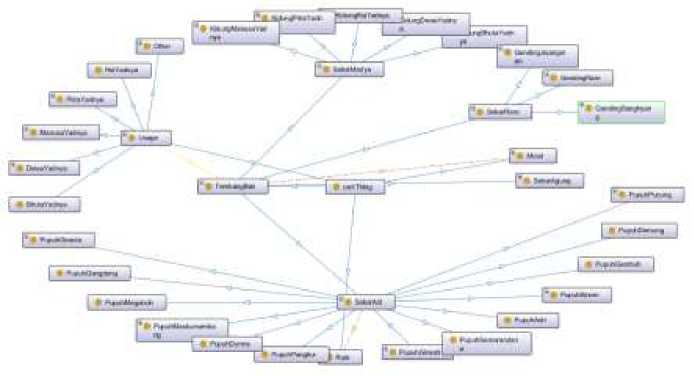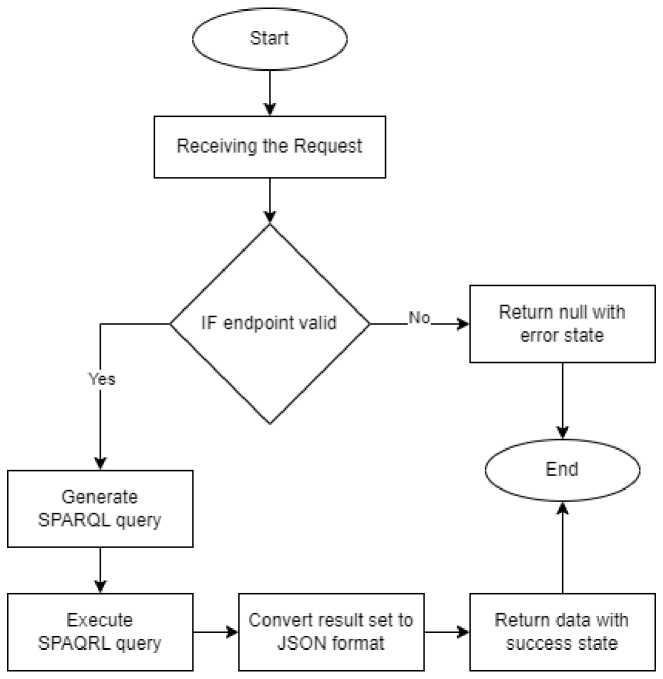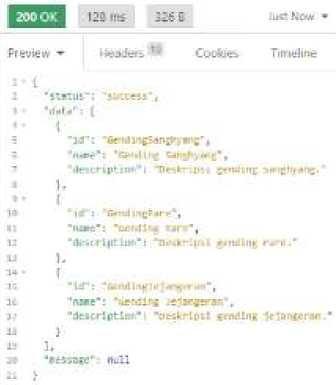Application Programming Interface (API) with Representational State Transfer (REST) for Balinese Traditional Song Semantic Ontology
on
JNATIA Volume 1, Nomor 1, November 2022
Jurnal Nasional Teknologi Informasi dan Aplikasinya
Application Programming Interface (API) with Representational State Transfer (REST) for Balinese Traditional Song Semantic Ontology
Kadek Andre Suryanaa1, Made Agung Raharjaa2, Cokorda Pramarthab3
aNet-Centric Computing Laboratory, Udayana University
South Kuta, Badung, Bali, Indonesia 1Andresuryana17@gmail.com 2made.agung@unud.ac.id 3cokorda@unud.ac.id
Abstract
Technological developments and the era of globalization greatly affect the development of cultural heritage. One of the local cultural heritages in Bali is the Balinese traditional song. Balinese traditional songs are commonly used in traditional ceremonies or sung by children. In this study, the author uses semantic ontology technology to store knowledge in the form of a knowledge graph which will then be accessed through a query process to the Apache Jena Fuseki with a SPARQL query. This research succeeded in developing microservices in the form of a REST API to help receive and send requests properly. The REST API that has been created has successfully passed the test scenarios that have been carried out in this research.
Keywords: Ontology, Semantic, REST API, Balinese Traditional Song, Cultural Heritages
Technological advances, modernization, globalization are considered new forces that marginalize local cultural heritage, which occurs because modern media such as radio and television are present more as channels for the spread of Western culture to various corners of the world, especially to developing Eastern countries [1]. One of the local cultural heritages affected is the Balinese traditional song. The Balinese traditional song is one of the local cultural heritages in the form of sound art which is built from various tunings and tones as the material [2]. Balinese traditional songs are usually used in traditional ceremonies or as children's songs. Along with the development of the era of Tembang learning, there has been a shift from using conventional learning media until now it has developed to interactive learning media based on information technology, especially the learning of Tembang Bali [3].
Today, the rapid development of digital technology has created more innovative cultural heritage preservation opportunities to represent digital cultural heritage knowledge and to connect people who have knowledge of cultural heritage with others who want to acquire the knowledge [4]. Digital cultural heritage opens opportunities for the community and the younger generation in particular to represent and contribute to the further development of cultural heritage [5].
Current technological developments, especially multiplatform technology that includes mobile and web-based applications, allow applications that can represent cultural heritage with an ontology approach that will help provide an explicit explanation of this knowledge [6]. Ontology is a way to represent knowledge from a domain in an explicit form about a concept equipped with meanings on objects, properties, and relations between these objects so as to form a knowledge base [6]– [9]. Ontologies can facilitate machines to process data and understand that structured and semistructured information can be represented explicitly by ontologies semantically [10].
Ontology stores data in the form of knowledge charts that can only be requested using a RDF dump or SPARQL endpoint, requiring time and experienced ontology engineers [11]. W3C standards such as SPARQL and RDF remain unknown to most web developers, making it difficult for them to obtain data on ontological graphs [12]. The REST (Representational State Transfer)
Jurnal Nasional Teknologi Informasi dan Aplikasinya
API (Application Programming Interface) is an architecture used to design microservices used across multiple platforms and has become a widely followed architectural standard for creating microservices that can be consumed by cross-platform [13].
The purpose of this study is to understand and apply how to integrate the Balinese Tembang ontology data from microservices with various systems or multiplatform, such as web applications or mobile applications. To be easily accessible, microservices through various platforms are required. One of the more widely used architectures is the REST API (Representational State Transfer Application Programming Interface) that relies on HTTP (Hypertext Transfer Protocol) to send and receive data.
In this study, the waterfall method was used and adapted to the needs of the study. Waterfall is the most widely used approach to software development. There are several major steps in this study, the major steps refer to the waterfall model [14]. The steps for this research are shown in Figure 1.

Figure 1. Research Method Model
The first step is analysis, at this stage an analysis of the problems that are being experienced and want to be solved in this research is carried out. The system should be able to receive data requests on the client's side.
The second stage is design, at this stage a design of the ontology of the Balinese traditional song is made. The design of the ontology is shown in Figure 2.

Figure 2. Balinese Traditional Song Ontology Model
Jurnal Nasional Teknologi Informasi dan Aplikasinya
In this stage, flowchart design is also made of the system to be built. The flowchart design is shown in Figure 3. A flowchart shows the flow of the REST API. First, the system receives requests from client users. The system then validates the endpoint of the request. If the endpoint is valid, the system will generate her SPARQL queries as requested by the client user. The system then executes the generated SPARQL queries on the Apache Jena Fuseki server. The received data is formatted in JSON format and returned to the client user as a successful response.

Figure 3. Flowchart REST API
The third stage is implementation, at this stage a Balinese traditional song ontology model is made using the Protege tools which will then be stored on the Apache Jena Fuseki Server so that it can be queried with SPARQL. In addition, at this stage a REST API was also created using the PHP programming language and the help of the Laravel 8 framework.
The fourth step is testing, at this stage testing the REST API that has been built in the previous stage. Tests are carried out to validate the output generated from the request to the REST API.
The fifth stage is maintenance, at this stage the designed system has been completed. This stage is the maintenance of the system so that the system runs as it should.
In this section, the design and development of the REST API produces several endpoints as follows.
-
a. Get Balinese Traditional Song List
Jurnal Nasional Teknologi Informasi dan Aplikasinya
Endpoint : /v1/tembang
Method : GET
Description : Display a listing of the tembang bali
Request query : category, mood, usage, and rule
-
b. Get Balinese Traditional Song Categories
Endpoint : /v1/tembang/category
Method : GET
Description : Display a listing of the tembang categories
Request query : -
c.
Get Balinese Traditional Song Sub Categories
Endpoint Method Description Request query
: /v1/tembang/sub-category
: GET
: Display a listing of the tembang sub-categories
: name
REST API will be verified by using Insomnia. Insomnia is one of many REST API debugger applications.
Table 1. REST API Test Scenario
|
No. |
Test Scenario |
Expected Result |
Result |
Validation |
|
1. |
Perform a search by request query to endpoint ‘/v1/tembang’. Request query category ‘SekarRare’ and usage ‘bermain’. |
Return list of Balinese traditional songs with category ‘SekarRare’ and usage ‘bermain’. |
fte⅛w⅛ ∙ MeiderS CtxMues Tiffldifte 2 "StetW-J"; "ZHiteif1 I ∙ ⅜⅛⅛⅛ I
1 'M’: '≡f m jut:*’.
"IitegDrv-- -SeLkntMer4 rCIlitreJJtSfl Mill ι∙ I. U ∙Mbi ∙Λai*¼ dΛr'. "uW-jeVτ*: "till W { M “title" S "Wl ιΛ>rT. » 1. w βteM9βe*i mil |
Valid |
Jurnal Nasional Teknologi Informasi dan Aplikasinya
|
2. |
Perform request to endpoint ‘/v1/tembang/ category’. |
Return list of categories of Balinese traditional songs. |
142 tm IlH E «M*m#» ½o ∙ *3revιev∣ ∙ Headers κ Cookies TTOtine |
Valid |
|
*sUu"ι *<2k*dn∣.∣αrΛM*l t r Sftjcrtpt Ufl'' aIetar mw PissBut lup ■pU^ln M‰ MlTMB. BBA<u**v,i PilMrt alah «m | ||||
|
be* ani pe∏βe∙ι rUu ∙∙lf<M∙ Bentuk Bteu Jenli Seur Btrw IaiV-e bitt CΦ∏t*π Mrup* | ||||
|
PiUfMUiI PBdu MBtM upacara BaifMMfu ιidw StM l«r- l*cw JW lup» OlSftOut HtBftndIZiGnn Hms PLiftliPBBn ajBΓM.WiarM unila.* | ||||
|
3. |
Perform a |
Return error |
Valid | |
|
^^J IJlfTj 67 0 IUCKgw • | ||||
|
request to ‘/v1/tembang/ sub-category’ with invalid request query. |
with code 404 and message ‘Request query not found’. |
Preview * Iteadea * Cootaes Tnnehne |
Jurnal Nasional Teknologi Informasi dan Aplikasinya
4.
Perform a request to ‘/v1/tembang/ sub-category’ with valid request query ‘SekarRare’.
Return list subcategory of category SekarRare.

Valid
The tests are performed by verifying the functional requirements of the REST API. The scenario for implementation is as follows in Table 1. The test scenarios that are run are simulations that client users can run. The purpose of this test is to minimize system errors and increase system reliability.
The results of the study that has been carried out, it can be concluded that the REST API that has been developed has succeeded in integrating the Balinese traditional song semantic ontology. And the test results with predetermined scenarios show satisfactory results with a validity level of 100%, namely 4 out of 4 tests carried out, the application can run as expected.
References
-
[1] I. N. D. Putra and I. A. L. Sari, ‘Revitalisasi Tembang Teks Sastra Bali Tradisional dalam
Ranah Ritual dan Digital’, ATAVISME, vol. 22, no. 1, pp. 32–46, Jun. 2019, doi: 10.24257/atavisme.v22i1.541.32-46.
-
[2] M. Agung Raharja, I. P. Gede Adiatmika, I. N. Adiputra, S. Purnawati, and I. W. Supriana,
‘IMPLEMENTASI METODE MEL-FREQUENCY CEPSTRAL COEFFICIENT DAN DTW PADA APLIKASI PENGENALAN SUARA TEMBANG SEKAR ALIT’, Jurnal Resistor, vol. 5, no. 1, pp. 65–71, 2022, [Online]. Available: https://s.id/jurnalresistor
-
[3] M. Agung Raharja, S. Purnawati, I. P. Gede Adiatmika, I. N. Adiputra, and I. B. Alit
Swamardika, ‘Usability Analysis of Tembang Sekar Alit Learning (SekARAI) Applications Using The Human Computer Interaction (HCI) Model In Bali Students’, in Proceedings of the Second Asia Pacific International Conference on Industrial Engineering and Operations Management, 2021, pp. 2870–2879.
-
[4] C. Pramartha, J. G. Davis, and K. K. Y. Kuan, ‘A Semantically-Enriched Digital Portal for
the Digital Preservation of Cultural Heritage with Community Participation’, in 7th International Conference, EuroMed 2018, 2018, pp. 560–571. [Online]. Available:
http://www.springer.com/series/7409
-
[5] C. Pramartha, ‘Assembly the Semantic Cultural Heritage Knowledge’, Jurnal Ilmu
Komputer, vol. 11, no. 2, pp. 83–95, 2018, [Online]. Available: http://www.cidoc-crm.org
-
[6] A. W. Widiatmika and C. Pramartha, ‘Balinese Kulkul Semantic Ontology: REST API
Mobile Application Development’, Jurnal Elektronik Ilmu Komputer Udayana, vol. 9, no. 4, pp. 457–466, May 2021.
-
[7] J. Elektronik, I. K. Udayana, P. R. Ganeswara, C. Rai, and A. Pramartha, ‘Ontology-Based
Approach for Klungkung Royal Family’, vol. 8, no. 4, pp. 2654–5101, 2020.
-
[8] I. L. Koten and C. Pramartha, ‘Semantic Representation of Balinese Traditional Dance’,
JELIKU (Jurnal Elektronik Ilmu Komputer Udayana), vol. 8, no. 4, pp. 411–419, 2020.
Jurnal Nasional Teknologi Informasi dan Aplikasinya
-
[9] M. Wardana and C. Pramartha, ‘Development of Semantic Ontology Modeling in
Knowledge Representation of Balinese Gamelan Instruments’, JELIKU (Jurnal Elektronik Ilmu Komputer Udayana), vol. 8, no. 2, pp. 145–152, 2019.
-
[10] K. Dwi Pradnyani Novianti, N. Akhmad Setiawan, and S. Suning Kusumawardani, ‘Perancangan Ontologi sebagai Teknologi Penyimpanan Informasi untuk Penelusuran Pustaka pada SIRREF JTETI UGM’, 2014.
-
[11] C. Pramartha, ‘Pengembangan Ontologi Tujuan Wisata Bali Dengan Pendekatan Kulkul Knowledge Framework’, SINTECH (Science and Information Technology) Journal, vol. 3, no. 2, pp. 77–89, Oct. 2020, doi: 10.31598/sintechjournal.v3i2.592.
-
[12] D. Garijo and M. Osorio, ‘OBA: An Ontology-Based Framework for Creating REST APIs for Knowledge Graphs’, doi: 10.5281/zenodo.3686266.
-
[13] A. Ehsan, M. A. M. E. Abuhaliqa, C. Catal, and D. Mishra, ‘RESTful API Testing Methodologies: Rationale, Challenges, and Solution Directions’, Applied Sciences (Switzerland), vol. 12, no. 9. MDPI, May 01, 2022. doi: 10.3390/app12094369.
-
[14] E. Pawan, R. H. H. Thamrin, P. Hasan, S. H. Y. Bei, and P. Matu, ‘Using Waterfall Method to Design Information System of SPMI STIMIK Sepuluh Nopember Jayapura’, International Journal of Computer and Information System (IJCIS), vol. 02, no. 02, pp. 34–39, May 2021, [Online]. Available:
https://ijcis.net/index.php/ijcis/index
Jurnal Nasional Teknologi Informasi dan Aplikasinya
Halaman ini sengaja dibiarkan kosong
716
Discussion and feedback